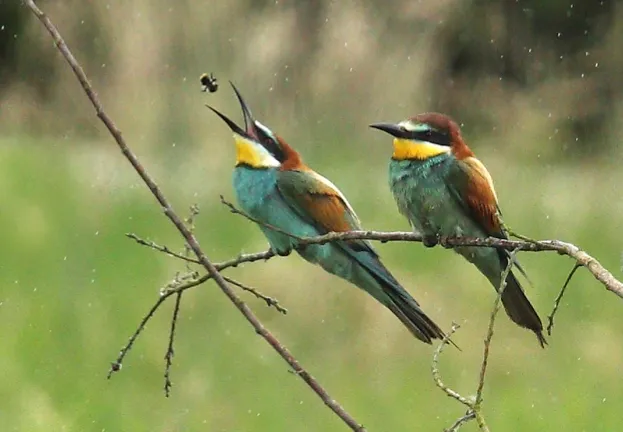European bee-eaters have been seen in Nottinghamshire for the first time in over 45 years, and look set to breed there.
The first bird was spotted on 25 June by a local birdwatcher, and by mid-morning on 26 June, a total of seven bee-eaters were seen at the quarry.
They have been regularly mating and passing food to each other – a strong indication that they are going to breed at the site.
WATCH THE VIDEO
Video of the bee-eaters, showing courtship feeding. © Andrew Chick
Bee-eaters feed on a range of invertebrates, including bees, dragonflies, butterflies and moths.
They are usually found in mainland Europe and parts of Africa, though a few are seen in the UK each year.
In the last 50 years, the species has only attempted to breed a handful of times in Britain.
If the bee-eaters at the quarry do breed, they are expected to stay until mid-August.

The quarry is owned by CEMEX, who have been working with Nottinghamshire Wildlife Trust to encourage wildlife on the site.
When quarrying ends, part of the quarry will be handed over to the Trust to form a new nature reserve.
“The presence of seven bee-eaters at East Leake quarry is a colourful ornithological tribute to an existing dynamic partnership between Nottinghamshire Wildlife Trust and the quarry operators CEMEX,” said Dr Rob Lambert, vice president of the Trust.
“Sensitive conservation advice working alongside industry has created suitable wetland and sandbank habitats for a thriving sand martin colony, and serendipitous homes for new southern European neighbours.”
Bee-eaters are a protected species in the UK, and are listed as Schedule 1 species in the Wildlife and Countryside Act 1981. As a result, it is an offence to deliberately or recklessly disturb them at their nest.
Main image: There are seven bee-eaters in total at the quarry. © Sean Browne
